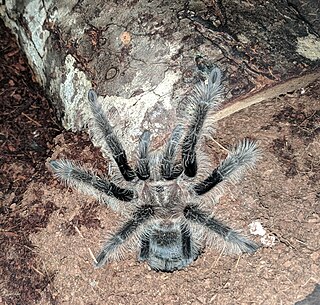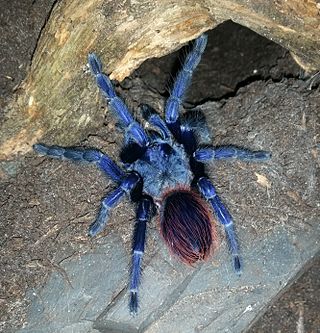
Theraphosa is a genus of South American tarantulas that was first described by Charles Athanase Walckenaer in 1805. The Theraphosa spiders are some of the largest known to science. As of May 2020 it contains three species, found in Guyana, Brazil, Venezuela, and Colombia. They stridulate by rubbing setae on their pedipalps and legs.

Pterinochilus murinus or the orange baboon tarantula, is a nocturnal spider in the family Theraphosidae that was first described in 1897 by Reginald Innes Pocock. This species is found in Angola, as well as central and southern Africa. It is a member of the subfamily Harpactirinae, baboon spiders.

Tliltocatl albopilosus is a species of tarantula, also known as the curlyhair tarantula. The species' native range is Nicaragua and Costa Rica. They are largely terrestrial, opportunistically burrowing spiders.

Tarantulas comprise a group of large and often hairy spiders of the family Theraphosidae. As of December 2023, 1,100 species have been identified, with 166 genera. The term "tarantula" is usually used to describe members of the family Theraphosidae, although many other members of the same infraorder (Mygalomorphae) are commonly referred to as "tarantulas" or "false tarantulas". Some of the more common species have become popular in the exotic pet trade. Many New World species kept as pets have setae known as urticating hairs that can cause irritation to the skin, and in extreme cases, cause damage to the eyes.

The Mexican redleg or red-legged tarantula is a species of terrestrial tarantula closely related to the famous Mexican redknee tarantula. Like the redknee it is a docile tarantula and popular in the pet trade. It is slow growing and, like many tarantulas, females can live for decades.

Lasiocyano is a genus of tarantulas. As of June 2023, it was a monotypic genus with the sole species Lasiocyano sazimai, synonym Pterinopelma sazimai, known as the Brazilian blue, iridescent blue or Sazima's tarantula. The species was first described by Rogério Bertani, Roberto Hiroaki Nagahama and Caroline Sayuri Fukushima in 2011. In 2012, it became the first Brazilian species to appear on the International Institute for Species Exploration's top 10 new species list. The species name honors Ivan Sazima, a Brazilian zoologist who was the first to collect exemplars of the species. It is now considered an endangered species owing to smuggling and a shrinking habitat.

Aphonopelma moderatum is a species of spider in the family Theraphosidae, found in United States, in the state of Texas. Commonly called the Rio Grande Gold Tarantula as they are found in the Rio Grande Valley of Texas.

Aphonopelma bicoloratum, is a species of tarantula found in Mexico. As its common name aptly states it is found in Mexico, and was first described by Ronny Struchen, D. Brändle and Gunter Schmidt in 1996. It is named after the Latin word bicoloratum, meaning bicolored.
Kochiana is a monotypic genus of Brazilian tarantulas containing the single species, Kochiana brunnipes or the dwarf pink leg. It was first described by C. L. Koch in 1841 under the name "Mygale brunnipes", and was transferred to its own genus in 2008. As of April 2020, it has only been found in Brazil.
Clavopelma is a monotypic genus of Mexican tarantulas containing the single species, Clavopelma tamaulipeca. It is a reddish-brown spider with thick, wooly golden-brown hair. Its legs are a darker shade of brown than the carapace, with setae that are stiffer than the hair on its body. Both sets of eyes are more or less equal in length, though the forward set is sharply procurved.
Metriopelma is a monotypic genus of Mexican tarantulas currently containing the single species, Metriopelma breyeri. It was first described by Léon Becker (1826–1909) in 1878, and originally found by Eugenio Dugès (1834–1895). This tarantula was named after Albert Breyer (1812–1876), a fellow entomologist. It is native to Mexico in the state of Guanajuato.

Avicularia juruensis is a species of spider in the family Theraphosidae, found in South America. Avicularia urticans was brought into synonymy in 2017. It has been given the English name Amazonian pink toe spider. Under the synonym Avicularia urticans, it is also known as the Peruvian pinktoe tarantula. It is a large mygalomorph spider, with a maximum body length over 30 mm (1.2 in) and the longest fully extended leg about 60 mm (2.4 in). Like other species in the genus Avicularia, specimens under this name are sold as pets, although their identity has not been confirmed by taxonomic studies.

Avicularia minatrix also known as the Red Slate Pink Toe, Redstripe Pinktoe or Venezuelan Redstripe Tarantula is a species of spider in the family Theraphosidae, found in Venezuela and Brazil. It was first described by Reginald Innes Pocock in 1903, being arboreal in nature and quite reclusive, and also the smallest tarantula of the Avicularia genus.
Sandinista lanceolatum is a species of spider in the family Theraphosidae (tarantulas), native to Nicaragua and Costa Rica.
Cymbiapophysa is a genus of spiders in the family Theraphosidae, first described by Pocock, in 1903. As of 2022 it contains 4 species. The tarantulas of this genus inhabit Central America. Males of this genus can be distinguished by the presence of a distal retrolateral apophysis on the cymbium of the male pedipalp. And females can be distinguished with twin spermathecae, by the morphology and the short and squat receptacles.
Hapalotremus chespiritoi is a tarantula in the Hapalotremus genus, first described by Nelson Ferretti, Patricio E. Cavallo, Juan C. Chaparro, Duniesky Ríos Tamayo, Tracie A. Seimon and Rick C. West in 2018. It is found in Peru, Patambuco, very close to Sicuani. This tarantula is named after Roberto Gómez Bolaños. The shape of the spermatheca of female of Hapalotremus chespiritoi resembles the small antennae of el "Chapulín Colorado", a comical superhero created by R.G. Bolaños.
Eucratoscelus pachypus also known as the Tanzania stout leg baboon tarantula or the stout leg tarantula, was first described by Gunter Schmidt and Volker von Wirth in 1990. It is found in Tanzania, hailing from arid parts, and is an obligate burrower.
Cyriocosmus leetzi also known as the Columbian dwarf tiger or Venezuelan dwarf beauty tarantula is a tarantula which was first described by Fabian Vol in 1999. As its common names may suggest it is found in Colombia, with some people stating it is also found in Venezuela.
Pamphobeteus fortis also known as the Colombian giant copperhead or Colombian giant brown tarantula is a tarantula which was first described by Anton Ausserer in 1875. As its common name aptly states it is found in Colombia, Venezuela and Panama.
Pamphobeteus vespertinus also known as the Ecuadorian red bloom tarantula is a tarantula first described in 1889 in Eugène Simon. They are found in the arid areas of Ecuador, and they are terrestrial tarantulas.









